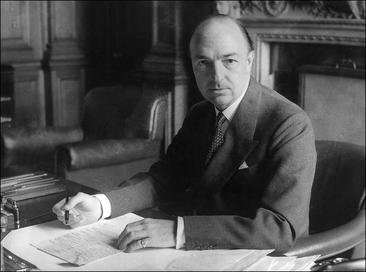John Profumo, the British Secretary of State for War, resigns in a sex scandal known as the “Profumo affair”.

On June 5, 1963, British Secretary of War John Profumo resigns his post following revelations that he had lied to the House of Commons about his sexual affair with Christine Keeler, an alleged prostitute. At the time of the affair, Keeler was also involved with Yevgeny “Eugene” Ivanov, a Soviet naval attache who some suspected was a spy. Although Profumo assured the government that he had not compromised national security in any way, the scandal threatened to topple Prime Minister Harold Macmillan’s government.
Age 48 in 1963, John Dennis Profumo was appointed secretary of war by Macmillan in 1960. As war minister, he was in charge of overseeing the British army. The post was a junior cabinet position, but Profumo looked a good candidate for future promotion. He was married to Valerie Hobson, a retired movie actress, and the Profumos were very much at the center of “swinging ’60s” society in the early 1960s. One night in July 1961, John Profumo was at the Cliveden estate of Lord “Bill” Astor when he was first introduced to 19-year-old Christine Keeler. She was frolicking naked by the Cliveden pool.
Keeler was at Cliveden as a guest of Dr. Stephen Ward, a society osteopath and part-time portraitist who rented a cottage at the estate from his friend Lord Astor. Keeler was working as a showgirl at a London nightclub when she first met Dr. Ward. Ward took her under his wing, and they lived together in his London flat but were not lovers. He encouraged her to pursue sexual relationships with his high-class friends, and on one or more occasions Keeler apparently accepted money in exchange for sex. Ward introduced her to his friend Ivanov, and she began a sexual relationship with the Soviet diplomat. Several weeks after meeting Profumo at Cliveden, she also began an affair with the war minister. There is no evidence that either of these men paid her for sex, but Profumo once gave Keeler some money to buy her mother a birthday present.
After an intense few months, Profumo ended his affair with Keeler before the end of 1961. His indiscretions might never have come to public attention were it not for an incident involving Keeler that occurred in early 1963. Johnny Edgecombe, a West Indian marijuana dealer, was arrested for shooting up the exterior of Ward’s London flat after Keeler, his ex-lover, refused to let him in. The press gave considerable coverage to the incident and subsequent trial, and rumors were soon abounding about Keeler’s earlier relationship with Profumo. When Keeler confirmed reports of her affair with Profumo, and admitted a concurrent relationship with Ivanov, what had been cocktail-party gossip grew into a scandal with serious security connotations.
On March 21, 1963, Colonel George Wigg, a Labour MP for Dudley, raised the issue in the House of Commons, inviting the member of government in question to affirm or deny the rumors of his improprieties. Wigg forced Profumo’s hand, not, he claimed, to embarrass the Conservative government but because the Ivanov connection was a matter of national security. Behind closed doors, however, British intelligence had already concluded that Profumo had not compromised national security in any way and found little evidence implicating Ivanov as a spy. Nevertheless, Wigg had raised the issue, and Profumo had no choice but to stand up before Parliament on March 22 and make a statement. He vehemently denied the charges, saying “there was no impropriety whatsoever in my acquaintanceship with Miss Keeler.” To drive home his point, he continued, “I shall not hesitate to issue writs for libel and slander if scandalous allegations are made or repeated outside the House.”
Profumo’s convincing denial defused the scandal for several weeks, but in May Dr. Stephen Ward went on trial in London on charges of prostituting Keeler and other young women. In the highly sensationalized trial, Keeler testified under oath about her relationship with Profumo. Ward also wrote Harold Wilson, leader of the Labour opposition in Parliament, and affirmed that Profumo had lied to the House of Commons. On June 4, Profumo returned from a holiday in Italy with his wife and confessed to Conservative leaders that Miss Keeler had been his mistress and that his March 22 statement to the Commons was untrue. On June 5, he resigned as war minister.
Prime Minister Macmillan was widely criticized for his handling of the Profumo scandal. In the press and in Parliament, Macmillan was condemned as being old, out-of-touch, and incompetent. In October, he resigned under pressure from his own government. He was replaced by Conservative Alec Douglas-Home, but in the general election in 1964 the Conservatives were swept from power by Harold Wilson’s Labour Party.
Dr. Stephen Ward fell into a coma after attempting suicide by an overdose of pills. In his absence, he was found guilty of living off the immoral earnings of prostitution and died shortly after without regaining consciousness. Christine Keeler was convicted of perjury in a related trial and began a prison sentence in December 1963. John Profumo left politics after his resignation and dedicated himself to philanthropy in the East End of London. For his charitable work, Queen Elizabeth II named him a Commander of the British Empire, one of Britain’s highest honors, in 1975.
Keeler’s autobiography, The Truth at Last: My Story was published in 2001. Profumo died on March 10, 2006, two days after suffering a stroke.



